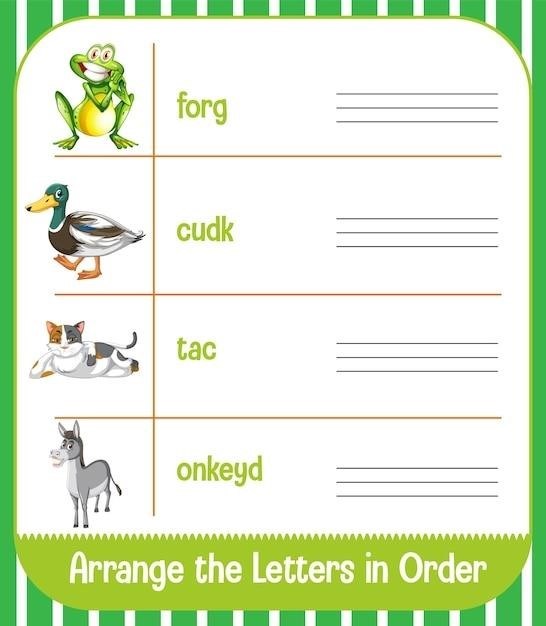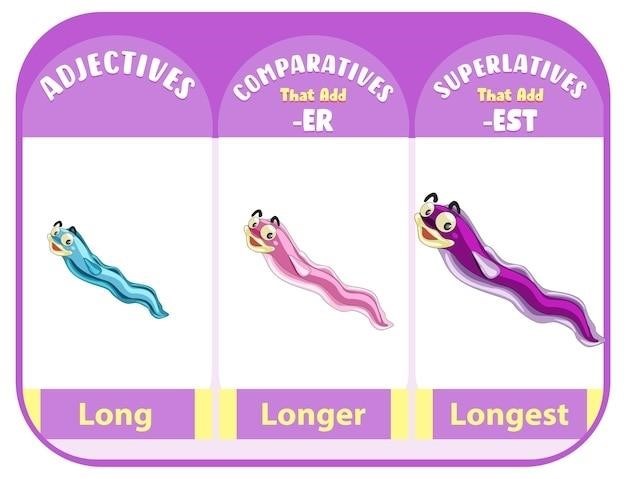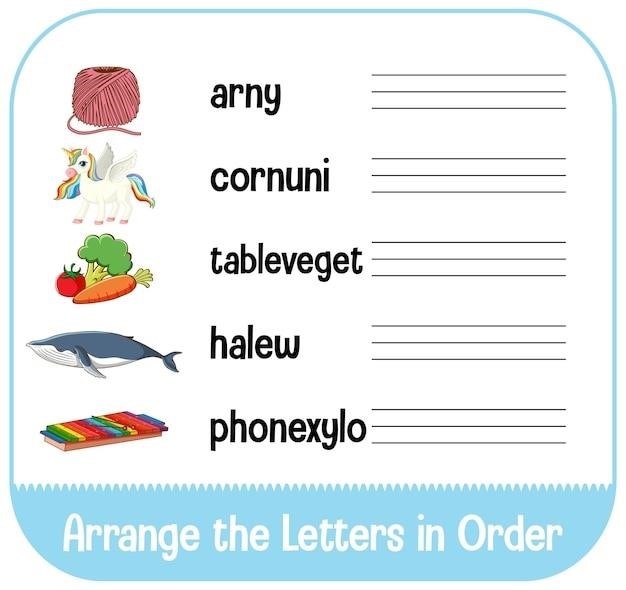Understanding Long and Short Vowel Sounds
English vowels possess both short and long pronunciations. Short vowels have a brief, concise sound, while long vowels are sustained and often closer to the letter’s name. Mastering these distinctions is crucial for accurate pronunciation and reading comprehension.
The English language utilizes five primary vowels⁚ A, E, I, O, and U. Each vowel possesses two distinct sounds⁚ a short and a long sound. Short vowel sounds are typically brief and concise, often found in short words like “cat,” “bed,” “pig,” “dog,” and “sun.” These sounds are usually the first introduced to young learners. Conversely, long vowel sounds are typically longer and often more closely resemble the letter’s name, as in “cake,” “feet,” “bike,” “coat,” and “cube.” However, it’s crucial to remember that long vowel sounds can be represented through various spellings, adding to the complexity of English phonics. Understanding the differences between these vowel sounds is foundational to reading and spelling proficiency. Many resources, including printable PDF charts and worksheets, are available to aid in learning and practicing these fundamental sounds. Effective teaching strategies involve utilizing interactive games and activities, making the learning process more engaging and memorable. Further exploration into different vowel contexts and utilizing technology-based learning tools can enhance comprehension and fluency.
Short Vowel Sounds⁚ A Comprehensive List
Let’s delve into the specifics of short vowel sounds. The short /a/ sound, as heard in words like “cat” and “map,” is often represented by the letter ‘a’. The short /e/ sound, exemplified by words such as “bed” and “pen,” is frequently spelled with the letter ‘e’. The short /i/ sound, found in words like “pig” and “fin,” typically uses the letter ‘i’ in its spelling. The short /o/ sound, as in “dog” and “hot,” is commonly represented by the letter ‘o’. Lastly, the short /u/ sound, heard in words like “sun” and “tub,” generally utilizes the letter ‘u’. Remember, these are common spellings, and exceptions exist. It is essential to familiarize yourself with these sounds and their various spellings to enhance reading and spelling skills. Many online resources and printable PDF worksheets provide further examples and practice exercises to help solidify understanding. These resources often include activities designed to help differentiate between short and long vowel sounds, improving pronunciation and comprehension. Consistent practice is key to mastering this fundamental aspect of English phonics.
Long Vowel Sounds⁚ A Detailed Overview
Long vowel sounds, in contrast to their short counterparts, generally sound like the letter name itself. The long /a/ sound, as in “cake” or “name,” can be spelled in various ways, including “ai,” “ay,” and “a_e.” The long /e/ sound, heard in words like “eat” or “me,” often employs spellings like “ee,” “ea,” and “e_e.” The long /i/ sound, as in “bike” or “pie,” is frequently spelled with “ie,” “i_e,” or “igh.” The long /o/ sound, heard in words such as “go” or “boat,” can be represented by “oa,” “ow,” “oe,” and “o_e.” Finally, the long /u/ sound, exemplified by words like “cube” or “blue,” is often spelled using “ue,” “u_e,” or “oo.” It’s crucial to note that long vowel sounds frequently have multiple spellings, making them more challenging for young learners. Numerous online resources and printable PDF worksheets are available to aid in understanding these complexities. These resources often include exercises focusing on various spellings of long vowel sounds, aiding in improved reading and writing abilities. Consistent practice remains key to mastering these vowel sounds and their diverse spellings.

Utilizing PDF Resources for Learning
Numerous websites offer free printable PDF resources for learning vowel sounds. These include charts, worksheets, and activities designed to reinforce understanding and improve pronunciation skills.
Finding Printable Vowel Sound Charts
The internet provides a wealth of printable vowel sound charts in PDF format. These charts are invaluable tools for visual learners, offering a concise and readily accessible reference guide. Many websites dedicated to phonics education offer free downloads, often categorized by vowel type (short or long) or even by grade level, making it easy to find resources suitable for different learning stages. Look for charts that clearly illustrate each vowel sound with its corresponding IPA symbol (International Phonetic Alphabet) for enhanced accuracy. Some charts include example words for each vowel sound, facilitating comprehension and aiding in pronunciation practice. Consider the layout and design; a clear, uncluttered chart is easier to understand and use, especially for younger learners. Remember to check the source’s credibility to ensure the information’s accuracy and reliability before utilizing the chart. These printable charts serve as an excellent supplementary learning aid, especially when combined with interactive exercises and activities. They are perfect for classroom use or home-schooling environments. A well-designed chart is an indispensable tool that significantly enhances the learning process.
Accessing Worksheets and Activities in PDF Format
Numerous websites offer downloadable PDF worksheets and activities focusing on long and short vowel sounds. These resources provide interactive exercises designed to reinforce learning and improve comprehension. Many worksheets incorporate various activities, such as matching vowel sounds to pictures, filling in missing vowels in words, or sorting words based on their vowel sounds. Some offer more advanced exercises involving sentence construction or reading comprehension passages focused on specific vowel sounds. The interactive nature of these worksheets makes learning engaging and fun. Look for worksheets that offer a variety of activities to cater to different learning styles. Consider the difficulty level; choose worksheets appropriate for the learner’s age and skill level. Many websites provide free resources, while others may offer subscription-based access to a broader range of materials. Remember to check the source’s reputation and the quality of the materials before downloading. The ability to print these PDFs makes them adaptable to different learning environments, both in the classroom and at home. These resources are excellent supplementary materials to enhance the learning process and improve pronunciation skills.
Effective Teaching Strategies
Employing multi-sensory techniques, such as visual aids and hands-on activities, significantly enhances the learning process. Incorporate games and interactive exercises to maintain student engagement and motivation. Regular practice and repetition are key to mastering vowel sounds.
Teaching Short Vowel Sounds to Young Learners
Begin by introducing the five short vowel sounds⁚ /æ/ (as in cat), /ɛ/ (as in bed), /ɪ/ (as in pin), /ʊ/ (as in bus), and /ʌ/ (as in cup). Use visual aids like colorful charts or flashcards with pictures and corresponding words. Engage learners through interactive activities such as rhyming games or sorting exercises. For example, have children sort pictures into categories based on their short vowel sounds. Encourage repetition and practice. Simple three-letter words (CVC words) are excellent for initial practice. Use repetitive phrases and songs to reinforce the sounds. Create a fun and engaging learning environment. Regular assessment is key to tracking progress and identifying areas needing further attention. Consider incorporating technology, such as educational apps or online games, to enhance learning and engagement. Remember to keep it fun and build confidence!
Introducing Long Vowel Sounds and Their Variations
After establishing a firm grasp of short vowels, introduce long vowel sounds, emphasizing that they often sound like the letter’s name (a as in “ape,” e as in “eat,” i as in “ice,” o as in “oat,” u as in “use”). Explain that long vowel spellings can be more complex than short vowels, often involving silent ‘e’ at the end (CVCe words), vowel digraphs (like ‘ee’ or ‘oa’), or diphthongs (like ‘oy’ or ‘ou’). Use various teaching methods like flashcards with pictures and words, interactive games focusing on spelling patterns, and reading aloud texts containing these words. Highlight the differences between long and short vowels using contrasting word pairs (e.g., “pin” vs. “pine,” “hat” vs. “hate”). Encourage students to identify and pronounce long vowel sounds in different word contexts. Provide ample opportunities for practice through reading, writing, and spelling activities. Consistent reinforcement is crucial for mastery.
Practical Application and Exercises
Reinforce learning through interactive exercises. Utilize online games, printable worksheets, and engaging activities to solidify understanding of long and short vowel sounds. Practice makes perfect!
Activities for Practicing Vowel Sounds
Engaging activities are key to mastering vowel sounds. Start with simple sorting exercises⁚ provide flashcards or a printed list of words, and have students categorize them based on whether they contain short or long vowels. This helps build phonemic awareness. Next, introduce rhyming activities. Choose words with the same vowel sound and have students identify the pattern. For example, use word pairs like “cat” and “hat” (short a) or “bike” and “like” (long i). This reinforces recognition of specific vowel sounds. For a more advanced exercise, create sentences using words with both short and long vowels. Have students read these sentences aloud, focusing on proper pronunciation of each vowel sound. Consider incorporating creative writing prompts. Ask students to write short stories or poems using words that feature both short and long vowels. This encourages application of their knowledge in a meaningful context. Remember to provide positive reinforcement and celebrate their progress. Regular practice is essential for solidifying these skills.
Games and Interactive Resources for Vowel Sound Learning
Transforming vowel sound practice into fun games significantly boosts engagement and retention. Online resources offer interactive games specifically designed for this purpose. Many websites and educational apps feature vowel sound matching exercises, where students drag and drop words with the same vowel sound into designated categories. These interactive games provide immediate feedback, allowing students to self-correct and reinforce learning. Consider incorporating classic games with a phonetic twist. Adapt familiar games like Bingo or memory matching by using word cards with short and long vowel sounds. This approach makes learning fun and competitive. For example, create Bingo cards with pictures representing words containing various vowel sounds. Call out the sounds, and students mark their cards accordingly. Another engaging option is a vowel sound scavenger hunt. Hide word cards around the classroom, and have students find and categorize them based on their vowel sounds. This active learning approach promotes physical movement and active participation. Remember to adjust the complexity of the games based on the students’ skill levels. The key is to keep the learning process enjoyable and motivating.

Advanced Concepts and Resources
Explore diphthongs and vowel combinations, delving into nuanced pronunciation and spelling patterns. Utilize online dictionaries and phonetic transcriptions for in-depth analysis.
Exploring Vowel Sounds in Different Contexts
Beyond isolated words, understanding vowel sounds requires examining their behavior within sentences and connected speech. The surrounding sounds can influence a vowel’s pronunciation, a phenomenon known as coarticulation. For example, the short ‘i’ in “pin” might sound slightly different when followed by a ‘t’ compared to an ‘n’. Furthermore, stress and intonation play a crucial role. A stressed vowel will often be longer and more distinct than an unstressed one. Consider the word “record”⁚ as a noun, the first syllable is stressed, resulting in a long ‘e’ sound; as a verb, the second syllable is stressed, yielding a short ‘e’. Analyzing vowel sounds in different grammatical contexts, such as prefixes and suffixes, also reveals subtle variations. Exploring these nuances enhances pronunciation accuracy and comprehension, particularly in spoken English. The impact of regional accents on vowel pronunciation further complicates the picture, highlighting the dynamic and multifaceted nature of English vowel sounds. Therefore, a comprehensive understanding necessitates looking beyond simple word lists and exploring vowels in their natural linguistic environment. Consider the variations in pronunciation across dialects, which can significantly alter the perception of both short and long vowel sounds.
Utilizing Apps and Online Resources for Vowel Sound Practice
Numerous apps and online resources offer interactive exercises and games to reinforce learning of long and short vowel sounds. Many platforms provide audio pronunciations by native speakers, enabling learners to compare their pronunciation and refine their skills. Interactive games often incorporate visual aids and feedback mechanisms, making the learning process more engaging and effective. Some apps feature personalized learning paths, adapting to the user’s progress and focusing on areas needing improvement. Online resources, such as educational websites and YouTube channels, offer supplementary materials, including videos, worksheets, and quizzes. These resources often provide various levels of difficulty, catering to learners of different proficiency levels. The availability of these digital tools allows for flexible and self-paced learning, complementing traditional classroom instruction. Remember to select reputable sources that emphasize accurate pronunciation and provide clear explanations. Combining app-based practice with other learning methods can maximize the effectiveness of your vowel sound training. Regular engagement with these resources significantly improves pronunciation and reading comprehension.
